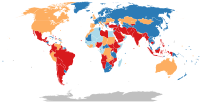
Photo from wikipedia
Purpose The aim of the study was to establish a hierarchy of strategies and the structure of copIng with the stress of the COVID-19 pandemic by university students and the… Click to show full abstract
Purpose The aim of the study was to establish a hierarchy of strategies and the structure of copIng with the stress of the COVID-19 pandemic by university students and the relationship between coping strategies and psychological well-being. Participants and Methods An exploratory study was conducted using a cross-sectional research design. The study involved 1330 university students, aged 18 to 30 years. The Brief COPE Scale, being the Polish adaptation by Juczyński and Ogińska-Bulik, and the short version of the Psychological General Well-Being Index (authors’ adaptation) were used. Results Acceptance, doing something else, active coping, and physical activity were the most commonly used strategies for coping with stress during the second wave of the pandemic. Substance use, denial, and behavioral disengagement were lowest in the hierarchy of coping strategies. Female and master’s students used a variety of strategies more than male and bachelor’s students. Coping strategies correlated significantly with psychological well-being. Four second-degree factors were distinguished, explaining 55.1% of the total variation: maladaptive coping, coping by support, by positive reappraisal, and by action. Stepwise regression analysis confirmed the importance of the second-degree factors as predictors of psychological well-being. Conclusion Our findings show that young adults studying at the university of physical Education in Poland used adaptive strategies to cope with stress during the second wave of the COVID-19 pandemic. Gender differences in coping with pandemic stress are similar to those found in previous studies. The structure of coping with pandemic stress is to some extent similar, but also partially dependent on various cultural factors.
Journal Title: Psychology Research and Behavior Management
Year Published: 2022
Link to full text (if available)
Share on Social Media: Sign Up to like & get
recommendations!